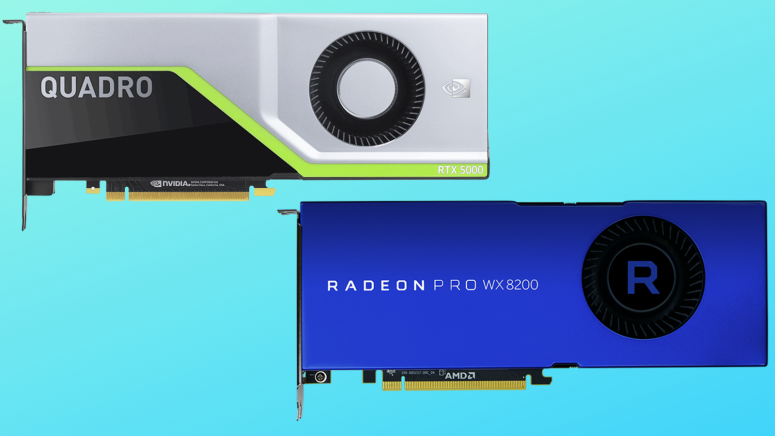
The Best Workstation Graphics Cards to Buy in 2021 For Compute-Intensive Applications
We have earlier seen some of the best graphics cards across NVIDIA and AMD targeted at gamers and VR enthusiasts. However, if you are on the lookout for a graphics card that can help with content creation, intensive computer applications, 3D modeling, etc., you need to invest in a workstation GPU. Workstation GPUs are based on a similar graphics core as their regular gaming counterparts but have more compute units unlocked and support ECC memory.
When it comes to rendering a scene, there isn't much of a difference between a workstation GPU and a gaming GPU of the same generation and make. However, the increased computing units in the workstation GPUs enable smoother viewport performance essential when creating complex scenes. Workstation GPUs also have dedicated drivers certified by independent system vendors (ISVs) for assured performance in their programs. This certification and the intensive testing that goes on before drivers are released adds to the cost of these already expensive GPUs.
With that information, here's a list of the 10 best workstation GPUs you should buy across all budgets.
1. PNY NVIDIA Quadro RTX 5000
The NVIDIA Quadro RTX 5000 is a workstation GPU from the latest Turing generation that supports new deep learning and ray tracing features. The RTX 5000 is great for those who are into require real-time photorealistic graphics capabilities. The Turing GPUs sport dedicated RT cores for ray tracing and Tensor cores for deep learning applications. The 3072 CUDA cores support a massive 11.2 TFLOPS of single-precision performance that can go up to 89.2 TFLOPS thanks to the Tensor cores. The 16 GB of GDDR6 memory allows for a bandwidth of 448 Gbps to render complex models and scenes with ease. You can also combine two such Quadro RTX 5000 cards for almost double the performance.
Performance-wise, the Quadro RTX 5000 leads the charts when pitted against the previous generation Pascal variants. While there are a couple of other Quadro RTX cards above the RTX 5000, including the RTX 6000 and the top of the line RTX 8000, the RTX 5000 comes across as one of the best workstation GPUs despite its heavy price tag.
- Pros: Excellent performance; Dedicated ray-tracing cores
- Cons: Expensive
2. PNY NVIDIA Quadro P6000
While the Pascal architecture has been a great success in the consumer space, NVIDIA has qualified the same for the professional market as well. The Quadro P6000 offers 24 GB of GDDR5X ECC memory with a bandwidth of 9 Gbps and all shader units enabled. The NVIDIA Titan X is currently the best performing consumer GPU in the Pascal series. Comparing the P6000 with the Titan X, we find that the P6000 offers 3840 CUDA cores while the Titan X offers 3584 CUDA cores. This Quadro card offers 12 TFLOPS of single-precision compute, which should find good use in intense AI and rendering applications. For all this performance, the power consumption is reasonably lower at 250 W. The P6000 offers four DisplayPort 1.4 outs and a dual-link DVI output. You can use HDMI converters if your display does not have DisplayPort connectors. The P6000 supports NVIDIA Quadro Scalable Visual Solutions (SVS). You can sync up to four Quadro P6000 cards to drive 16 displays from a single configuration.
The Quadro P6000 is one of the most powerful workstation cards in the market, and it performs above the competition in the majority of the tests. Although it does lose out in some tests to AMD's offerings, the overall numbers are still high. If you are upgrading from a previous generation Maxwell M6000, the speed boost is immediately noticeable. The Pascal architecture's advantage is the fewer emissions and higher compute performance with a couple of new platform-exclusive features. The Quadro P6000 does not come cheap but then, these cards are best suited for professionals and number crunchers than gamers.
- Pros: Excellent performance; 24 GB memory
- Cons: Expensive; Performance hits in few OpenCL workloads
3. AMD Radeon Pro WX 8200
The AMD Radeon Pro WX 8200 is a Vega10-based GPU for workstation users that offers excellent compute performance for a significantly lower price than NVIDIA's offerings. The Radeon Pro WX 8200 offers 3584 stream processors (56 compute units) that deliver a half-precision peak performance of 21.5 TFLOPs and a single-precision peak performance 10.75 TFLOPs. The card features 8 GB of HBM2 memory that offers a total bandwidth of 512 Gbps. Although the WX 8200 has half the memory of the more expensive WX 9100, the former has higher memory clocks, increasing memory bandwidth. The WX 8200 offers only mini DisplayPorts and no full-size HDMI or DP outs. That shouldn't be a problem, though, as you can use adapters for the same. The card can run all ports simultaneously via AMD Eyefinity technology. It also supports 10-bit color and 3D stereo output.
The Radeon Pro Wx 8200 gives a tight competition to the NVIDIA Quadro P4000 and the P5000. The performance in several compute benchmarks is much higher than the P4000 and is almost on par with the P5000. The NVIDIA cards are power-efficient, but the Radeon WX 8200 is not too behind either. The USP of this card is its price. The WX 8200 is currently one of the best workstation GPUs under $1,000, and you'll be hard-pressed to find anything else that can compete with it at this price. Another good thing about the new Radeon cards is that AMD allows you to switch between professional and gaming drivers if you want to test out gaming performance.
- Pros: Good value for money; Well-priced; Driver switching between gaming and professional workloads
- Cons: Offers only Mini-DP ports
4. PNY NVIDIA Quadro P5000
The NVIDIA Quadro P5000 is a high-end workstation GPU in the NVIDIA Pascal lineup. The P5000 offers more CUDA Cores and more memory than the cards placed below it, which should help handle complex graphics better. The 16 GB of GDDR5X is ECC enabled, which allows for accurate handling of large textures without errors. This memory has a bandwidth of up to 288 Gbps, and the GPU has a maximum boost clock of 1,733 MHz. You can daisy chain up to 32 external displays by connecting multiple Quadro cards via the Quadro Sync II add-in card. Thanks to the 2560 CUDA Cores, the P5000 can offer up to 9 TFLOPs of processing power along with enterprise-focused features such as Simultaneous Multi-Projection and Lens Matched Shading.
Compared to the Maxwell-generation, the new Pascal P5000 offers a significant performance bump in benchmarks such as SiSoft Sandra, SPECviewperf, and Luxmark. The P5000 can also double-up as a good workstation GPU for gaming if you desire, but we feel it is an overkill for gamers unless they like top benchmark charts and beat records. However, the Quadro cards have all the shader units unlocked for that particular GPU type, so they have better performance than corresponding consumer gaming GPUs. Another major advantage of the Pascal workstation GPUs is that they offer more performance at lower TDP than the previous Maxwell generation.
- Pros: Excellent performance in industrial applications
- Cons: Expensive
5. AMD Radeon Pro WX 7100
Before the Radeon Pro series, AMD had the FirePro brand of workstation GPUs that were popular for their low-cost high-performance and were used in many rendering applications. The Radeon Pro now offers an upgrade to the latest Polaris GPU cores tuned to take on heavy textures. The AMD Radeon Pro WX 7100 can be considered a workstation variant of the popular mid-range gaming GPU, the Radeon RX 480. The Radeon Pro WX 7100 offers a lower entry cost into professional graphics than NVIDIA's offerings. The Radeon WX 7100 is designed to fit in slim chassis and has a very low overall profile. It also doesn't require too much power and can make do with a single 6-pin cable. You also get four DisplayPort 1.4 outs to handle four 4K displays or two 5K ones. A unique aspect of the WX 7100 is the cooling system. Internally, the WX 7100 has a vapor chamber with aluminum fins to help with better heat dissipation.
Compared to the previous generation FirePro cards, the Radeon Pro offers much-improved performance in synthetic benchmarks although, it does trail slightly behind the Quadro M4000. The Radeon Pro WX 7100 offers 5.7 TFLOPs of single-precision performance, which may be useful for those running demanding applications such as SolidWorks. There have been several BIOS issues with the Radeon Pro WX 7100, but it is easily better than some of the last-gen Quadro cards in comparison. As long as your workflow is not locked into NVIDIA's CUDA architecture, the Radeon WX 7100 offers a compelling alternative.
- Pros: Good performance improvements over the previous generation
- Cons: Lags behind the Quadro M4000 in some tests; BIOS issues
6. NVIDIA Quadro P2000
The NVIDIA Quadro P2000 is based on the Pascal architecture and is an entry-level workstation GPU. The P2000 is similar to the consumer GeForce GTX 1060 but comes with a few shader units disabled. The Quadro P2000 offers 1024 CUDA cores, 64 texture mapping units, and 40 Raster Operation Pipelines. It comes with 5 GB of ECC GDDR5 memory and has a base clock of 1076 MHz that can boost up to 1480 MHz. The best part about this card is that it does not require a dedicated power supply and can run off the PCI Express slot power. You get four DisplayPorts, and you can use HDMI converters if your displays are HDMI compatible. The Quadro P2000 is aimed at those in the hunt for the best budget workstation GPU, so it foregoes some of the goodies such as stereo displays, NVIDIA video sync, and SLI connectors.
The NVIDIA Quadro P2000 can compete well against the AMD Radeon Pro WX 5100 in almost all tests. It won't be able to compete against some of the more powerful offerings but should be able to handle not-so-complex render pipelines with ease. In fact, the Quadro P2000 can pull ahead of even the Radeon Pro WX 7100 in certain benchmarks such as SPECviewperf. It is not a gamer-focused card by any stretch but does provide good performance in DirectX 12 games. The overall operation is also very silent, and the fan doesn't ramp up unless there is enough load.
- Pros: Value for money; No need for additional power supply
- Cons: Not enough power for certain demanding applications
Related: Best NVIDIA GPUs to Buy - Game Like a Pro
7. AMD Radeon Pro WX 5100
The AMD Radeon Pro WX 5100 is stacked right between the top-end WX 7100 and the entry-level WX 4100 and offers excellent performance for rendering simple scenes with not too many details. The Radeon Pro WX 5100 is compatible with both Enterprise and Crimson ReLive versions of the Radeon drivers, and you can choose to install either, depending on the stability requirement. Like the Quadro P2000, there is no need for external power as the WX 5100 can run well with just PCI Express power. The Radeon Pro WX 5100 is one of the cheapest workstation GPUs available, not counting the WX 4100, which is $100 lesser. However, the WX 5100 offers much better performance and more VRAM than the WX 4100, which is why we included it in our list.
Performance in benchmarks such as SPECviewperf is very good for a card in this price range, and the WX 5100 comes very near to the Quadro M2000. CUDA core acceleration in NVIDIA cards can offer some disadvantages to AMD. Still, in applications such as Adobe Premiere Pro, the WX 5100 easily competes with the Quadro K5000 and is better than the WX 4100 and the last-gen FirePro W4300. Interestingly, the power consumption under stress is lower compared to many NVIDIA Maxwell cards, which is an indicator that AMD has improved its efficiency. If you are a professional who likes to game whenever free, the WX 7100 makes for a better choice although, it is expensive. The WX 5100 is not too bad for games, but it is not well-optimized either as it lacks an external power supply.
- Pros: Power-efficient; Choice of driver types
- Cons: Not a very good performer in games
8. NVIDIA Titan V
Have you always yearned for a GPU that excels equally at both number and pixel crunching? If so, the NVIDIA Titan V is what you should be looking for. The Titan V comes with a massive price tag but also sports features to justify it. The Titan V brings a lot of power to the table thanks to the Volta architecture and requires a beefy power supply and hardware specs to make the best use of it. The GV100 GPU core houses a massive 21.1 billion transistor count, a base clock of 1200 MHz that can boost up to 1455 MHz, 12 GB of HBM2 memory, 5120 CUDA Cores, 2560 double-precision FP64 cores, 640 Tensor cores, 320 texture units, and 96 Raster operation pipelines. As you can see, the numbers themselves are the highest in the consumer market. The Titan V uses a 16-phase VRM for the GPU and has a TDP rating of 250 W, so you require two power connectors, 6-pin, and 8-pin. The card has three DisplayPort outs and one HDMI out. You can run 4K displays at 120 Hz, and 5K/8K displays at 60 Hz.
Needless to say, the performance of the Titan V is at the top of the charts in both gaming and scientific workflows. It beats the last-gen Titan XP by a good margin and leaves behind most AMD and gaming NVIDIA cards, including the flagship ones. Power consumption and fan noise are as expected, and there are no loud emissions. However, not many applications can scale up to take advantage of all the processing power that the Titan V offers, so we'd recommend evaluating your workload before purchase. Although this card can break any FPS record, we do not recommend this if you are going to use it only for gaming.
- Pros: Top of the line performance; Low emissions
- Cons: Expensive
9. AMD Radeon Vega Frontier Edition
The AMD Radeon Vega Frontier Edition was the first to launch with the new Vega GPU before the consumer Vega series debuted. The Vega 10 has 4096 stream processors, 256 texture mapping units, and 64 raster operation pipelines. The card sports 16 GB of HBM2 memory on a 2048-bit interface, so you get plenty of bandwidth for running demanding workstation apps. The card is rated at 300 W TDP, so you need two 8-pin power connectors to supply enough juice to the card. The Radeon Vega Frontier Edition caters to both gamers and workstation users. In fact, the Frontier Edition competes with the much more expensive and ISV-optimized WX series. It beats the WX 7100 when it comes to 2D acceleration in applications such as AutoCAD. In 3D applications, the Frontier Edition compares well with the Quadro P5000.
Gaming performance is right up there with the GTX 1080 but a bit lower than the GTX 1080 Ti. You can switch the drivers from Professional to Gaming, depending on your usage. This also makes it easy for developers to use Professional drivers for coding and Game drivers for testing the code. Power consumption is moderate for an AMD card, but the noise levels are slightly on the higher side. If your workloads are not dependent on CUDA cores, the AMD Radeon Vega Frontier Edition is the best workstation GPU for OpenCL applications.
- Pros: Great for both professionals and gamers
- Cons: High noise levels
10. XFX AMD Radeon Pro Duo
While it is not uncommon to find multi-GPU SLI or CrossFire setups, it definitely is rare to find two GPUs on a single PCB. The XFX Radeon Pro Duo is targeted at enthusiasts who demand a lot of GPU horsepower but still need it in a compact form factor. The specs of the Radeon Pro Duo seem a bit lesser than what is available in GPUs today, but the presence of dual GPUs helps in better multitasking. The Radeon Pro Duo features 8 GB of HBM RAM (4 GB per GPU) that runs at 500 MHz per memory. Each GPU offers 4096 stream processors and can run at 1000 MHz each. The Radeon Pro Duo comes with a water cooling solution that is often not seen in other GPUs unless you mod it. The Radeon Pro Duo excels most NVIDIA Maxwell cards in professional benchmarks apart from SPECviewperf, in which it severely lags behind the Quadro M6000. It could be that the benchmark is not well-optimized to take advantage of dual GPUs.
This card is definitely not solely for gamers, but you can still play modern titles at good frame rates. Since this is primarily a workstation GPU, it lags behind gaming-focused cards such as the GTX 980 Ti. The card runs quietly for an AMD solution, and the power draw is understandable considering that you have two GPUs on the PCB. Having said that, the Radeon Pro Duo does not come cheap. Also, with newer GPUs available in the market, it makes sense to combine two Vega cards to get more performance and still save money in the process. Not many applications can properly leverage the dual GPU setup, so you need to be sure your software can support this before dropping cash on this beast.
- Pros: Good gaming and workstation performance; Runs quiet
- Cons: Expensive
That was our take on the best workstation GPUs you should buy. Although workstation GPUs can also be used for gaming, they are not well optimized to run games at high frame rates. Add to the fact that these GPUs are very expensive, making them not an ideal choice if gaming is your priority.












